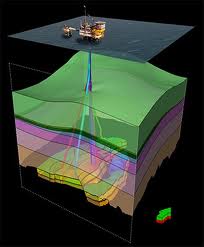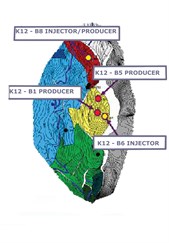Various monitoringMeasurement and surveillance activities necessary for ensuring safe and reliable operation of a CGS project (storage integrity), and for estimating emission reductions tools are used for monitoringMeasurement and surveillance activities necessary for ensuring safe and reliable operation of a CGS project (storage integrity), and for estimating emission reductions the K12-B storage(CO2Carbon dioxide) A process for retaining captured CO2Carbon dioxide, so that it does not reach the atmosphereThe layer of gases surrounding the earth; the gases are mainly nitrogen (78%) and oxygen (around 21%) complex, located in the Dutch sector of the North Sea. The storage(CO2Carbon dioxide) A process for retaining captured CO2Carbon dioxide, so that it does not reach the atmosphereThe layer of gases surrounding the earth; the gases are mainly nitrogen (78%) and oxygen (around 21%) demonstration project started in 2004 when a part of the CO2Carbon dioxide separated from the natural gasGas stored underground; It consists largely of methane, but can also contain other hydrocarbons, water, hydrogen sulphide and carbon dioxide, these other substances are separated before the methane is put into a pipeline or tanker extracted from the K12-B was re-injected into the same reservoirA subsurface body of rock with sufficient porosityMeasure for the amount of pore spaceSpace between rock or sediment grains that can contain fluids in a rock and permeabilityAbility to flow or transmit fluids through a porous solid such as rock to store and transmit fluids containing the gas deposit via injectionThe process of using pressure to force fluids down wells wellManmade hole drilled into the earth to produce liquids or gases, or to allow the injectionThe process of using pressure to force fluids down wells of fluids K12-B8. In 2005 the injectionThe process of using pressure to force fluids down wells started in another wellManmade hole drilled into the earth to produce liquids or gases, or to allow the injectionThe process of using pressure to force fluids down wells of fluids, K12-B6. The reservoirA subsurface body of rock with sufficient porosityMeasure for the amount of pore spaceSpace between rock or sediment grains that can contain fluids in a rock and permeabilityAbility to flow or transmit fluids through a porous solid such as rock to store and transmit fluids top is at 3,800 m depth below sea level and its cap rock is represented by rock salts alternating with clay intervals. Since 2004 a total of 60,000 tonnes of CO2Carbon dioxide has been injected.
A very important part of the monitoringMeasurement and surveillance activities necessary for ensuring safe and reliable operation of a CGS project (storage integrity), and for estimating emission reductions programme has been related to a continuous wellManmade hole drilled into the earth to produce liquids or gases, or to allow the injectionThe process of using pressure to force fluids down wells of fluids integrity assessment in relation to the specific down-hole conditions induced by the CO2Carbon dioxide injectionThe process of using pressure to force fluids down wells and storage(CO2Carbon dioxide) A process for retaining captured CO2Carbon dioxide, so that it does not reach the atmosphereThe layer of gases surrounding the earth; the gases are mainly nitrogen (78%) and oxygen (around 21%). For this purpose, several monitoringMeasurement and surveillance activities necessary for ensuring safe and reliable operation of a CGS project (storage integrity), and for estimating emission reductions tools were deployed, as multi-finger imaging tools (surveys in 2005 and 2006), cement bond logging, downhole video logging (2007), electromagnetic imaging tool, gamma ray logging (Fig. 3-5; Vandeweijer et al., 20112011 - V. Vandeweijer, B. van der Meer, C. Hofstee, F. Mulders, D. D'Hoore and H. GravenMonitoring the CO2 injection site: K12-Bsee more).
Gaining a better understanding of the behaviour of the CO2Carbon dioxide in the injectionThe process of using pressure to force fluids down wells wells and the migrationThe movement of fluids in reservoir rocks of the CO2Carbon dioxide in the reservoirA subsurface body of rock with sufficient porosityMeasure for the amount of pore spaceSpace between rock or sediment grains that can contain fluids in a rock and permeabilityAbility to flow or transmit fluids through a porous solid such as rock to store and transmit fluids were also important goals of the monitoringMeasurement and surveillance activities necessary for ensuring safe and reliable operation of a CGS project (storage integrity), and for estimating emission reductions programme. In order to achieve this goal, multiple reservoirA subsurface body of rock with sufficient porosityMeasure for the amount of pore spaceSpace between rock or sediment grains that can contain fluids in a rock and permeabilityAbility to flow or transmit fluids through a porous solid such as rock to store and transmit fluids models were built over the years using 3D seismic data, wellManmade hole drilled into the earth to produce liquids or gases, or to allow the injectionThe process of using pressure to force fluids down wells of fluids logs, production logs, etc. Additional measurements and analysis were used in order to refine these models, such as wellManmade hole drilled into the earth to produce liquids or gases, or to allow the injectionThe process of using pressure to force fluids down wells of fluids head production and injectionThe process of using pressure to force fluids down wells measurements, production and injectionThe process of using pressure to force fluids down wells analysis, down-hole pressure and temperature measurements, chemical tracerA chemical compound or isotope added in small quantities to trace flow patterns analysis and dynamic flow modelling (Vandeweijer et al., 20112011 - V. Vandeweijer, B. van der Meer, C. Hofstee, F. Mulders, D. D'Hoore and H. GravenMonitoring the CO2 injection site: K12-Bsee more).
|  
Fig. 3-5: Location, 3D visualisation and overview of relevant wells and compartments of the K12-B gas field (from Vandeweijer et al., 20112011 - V. Vandeweijer, B. van der Meer, C. Hofstee, F. Mulders, D. D'Hoore and H. GravenMonitoring the CO2 injection site: K12-Bsee more). |